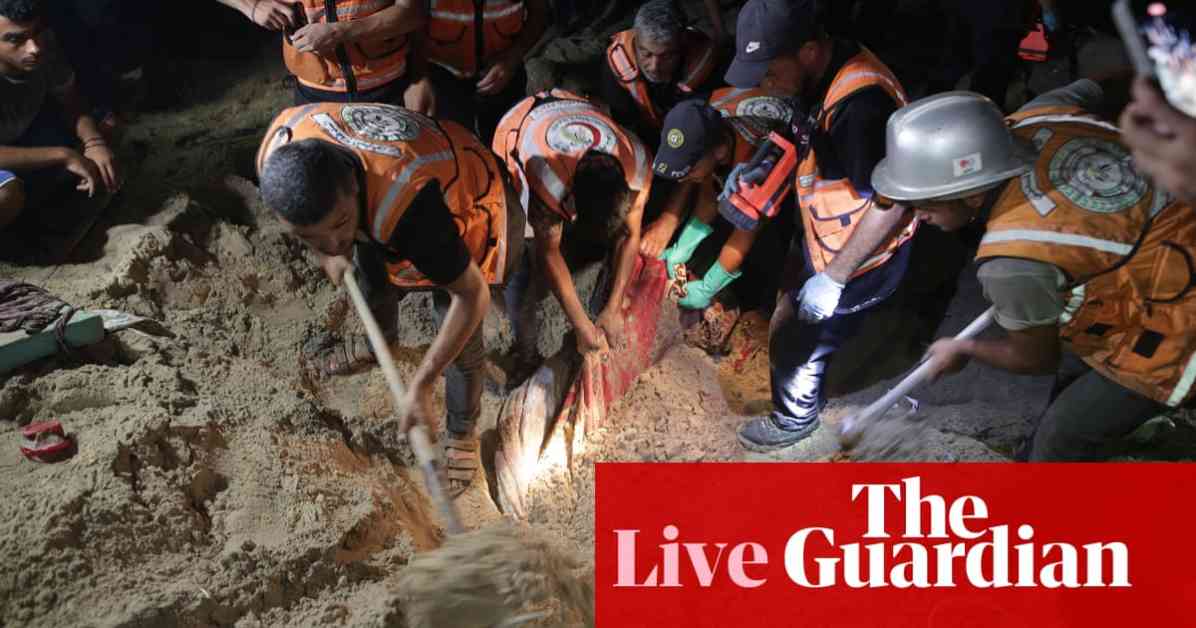Israel-Gaza Conflict: Dozens Killed in Israeli Strike on Khan Younis – Live Updates
The ongoing conflict between Israel and Gaza has once again escalated with a deadly Israeli strike on the Al-Mawasi humanitarian zone in Khan Younis, resulting in the deaths of at least forty people and injuring sixty others, according to Gaza’s civil defense agency. The strike, which targeted a Hamas command center embedded within the humanitarian area, has raised concerns about the safety of civilians in the region.
What is the Al-Mawasi humanitarian zone?
Al-Mawasi is a narrow strip of coastline at the southernmost end of Gaza, near the city of Khan Younis. In the midst of the conflict, the Israel Defense Forces (IDF) designated Al-Mawasi as a “humanitarian area” and urged residents of Gaza to evacuate there to avoid being caught up in the offensive launched in response to Hamas’s attacks into southern Israel. The IDF promised to provide international humanitarian aid as needed.
Throughout the conflict, the IDF has directed communities in active combat zones to seek refuge in Al-Mawasi. However, despite being designated as a humanitarian zone, Al-Mawasi has been the target of several deadly attacks. In previous incidents, a residential compound hosting medical teams from international NGOs was hit, and during a military operation, a house sheltering staff from Médecins Sans Frontières was fired upon, resulting in casualties.
The recent strike on Al-Mawasi reportedly killed forty people and wounded sixty others, with civil defense officials working to recover missing individuals buried under the sand. The attack has raised questions about the effectiveness of targeting militants within civilian areas and the impact on innocent lives caught in the crossfire.
Hamas denies militants were present at the site of the attack at Al-Mawasi
Hamas has refuted Israeli allegations that gunmen were present at the site targeted by the recent strikes in Al-Mawasi. In a statement, the group denied using civilian areas for military purposes and condemned the accusations as false. The Israeli military claimed to have struck significant Hamas terrorists operating within a command and control center hidden in the humanitarian area in Khan Younis.
Rescue efforts are underway at the tent encampment in Al-Mawasi, with reports of at least twenty tents catching fire and deep craters caused by the missiles. The aftermath of the attack has left many Palestinians dead and wounded, with ongoing search and rescue operations to retrieve victims buried under the debris. The conflicting narratives from both sides highlight the complexities of the situation and the challenges faced by civilians in conflict zones.
IDF’s approach to reduce harm to civilians
The Israel Defense Forces (IDF) have defended their actions, stating that steps were taken to minimize harm to civilians during the strike on Al-Mawasi. The IDF utilized precision weaponry, aerial surveillance, and additional intelligence information to target Hamas militants operating within the humanitarian area. Despite these efforts, the attack resulted in significant casualties and raised concerns about the impact on innocent civilians.
The use of military force in densely populated civilian areas like Al-Mawasi poses a dilemma for both sides, as ensuring the safety of civilians while targeting militant threats remains a complex challenge. The aftermath of the strike underscores the need for a more comprehensive approach to protecting civilian lives in conflict zones and addressing the root causes of the ongoing violence.
The broader context of the Israel-Gaza conflict
While the focus remains on the recent strike in Khan Younis, the broader context of the Israel-Gaza conflict highlights the complexities and challenges facing both sides. The Syrian Observatory for Human Rights reported Israeli airstrikes in Syria, resulting in casualties and drawing condemnation from Iran. The shift in focus towards Hezbollah and the Lebanese border by Israeli leaders signals a broader regional strategy amid escalating tensions.
The United Nations’ call for an end to the war in Gaza and the Palestinian Authority’s funeral procession for a slain activist underscore the human toll of the conflict. International pressure on Israel to alleviate the suffering of Palestinian civilians and uphold international norms highlights the need for a diplomatic resolution to the crisis. Australia’s coordination with allies to address the situation in Gaza reflects the global concern for the escalating violence and humanitarian crisis in the region.
As the conflict continues to unfold, the need for dialogue, diplomacy, and respect for international law remains paramount in resolving the underlying issues fueling the violence. The tragic events in Al-Mawasi serve as a stark reminder of the human cost of conflict and the urgent need for a peaceful resolution to the Israel-Gaza crisis.












